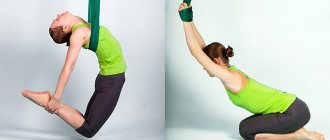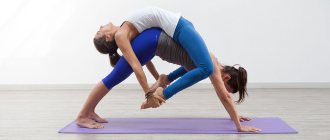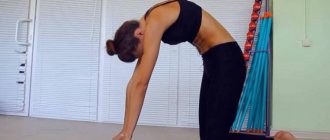In recent years, a fitness trend such as aerostretching has become increasingly popular. It is also called aerial yoga or yoga in hammocks. Aerostretching has quite deep roots; ancient monks who practiced yoga and spiritual relaxation trained in a similar way.
This sports direction is suitable for those who like a non-standard approach and have certain contraindications for other types of fitness, for example, problems with the spine, lower back, cervical region, etc.
Aerostretching provides gentle stretching and relaxation for the entire body and each muscle individually. During training, your body is in a state similar to the state of weightlessness, and this type of stretching gives peace and harmony with yourself and your own body.
If you are interested in this direction, then be sure to find out more about it. And now we will tell you everything...
The principle of aerostretching training
Aerostretching is essentially a mixture of yoga, stretching and aerial gymnastics. Classes are held in a special cloth, which is attached in the form of a loop to the ceiling using climbing carabiners. In some ways, this loop resembles a hammock, hence the second name of the direction - yoga in hammocks.
The level of load during aerostretching can be completely different: from gentle sagging and gentle muscle stretching, to complex exercises on a par with serious strength training.
In addition, some aerostretching trainers include elements of meditation in the training program, as in classical yoga, and cardio exercises, which allow you to sweat well and lose weight.
The workout begins as usual with a warm-up, which, as a rule, includes general warming up of the muscles of different groups, jumping rope and tapping the feet and palms on the mat.
After a fifteen-minute warm-up, light saggings are performed in the hammock up and down, the main purpose of which is to relieve tension from the spine and put all the vertebrae and joints back in place.
Then there may be exercises for swinging (based on the principle of a swing) and all kinds of twisting and twisting (as in aerial gymnastics). In addition, fabric hammocks can be used as a classic choreographic barre, helping to work out stretching exercises in even more detail.
Yoga in hammocks: Away from circus art and gravity
Aero yoga is a great opportunity to diversify your healthy lifestyle routine. Some people like to walk with the dog, others take up badminton or change into swimsuits for the pool, T-shirts and tops for training, and still others prefer anti-gravity yoga or fitness on silk ribbons, in hammocks.
Fly yoga can lift your mood and clear your mind
There is a huge selection of yoga hammocks
People started talking about aerial yoga seriously back in 2013. Then actress Gwyneth Paltrow shared a story about anti-gravity yoga on a social network. First, the craze for aerial silks captured America, and after the “aero art” of a healthy body, the rest of the world fell in love with it.
Yoga in hammocks is an easy way to master the most difficult asanas
Aerial ribbons were popular back in the 50s. thanks to dancer and gymnast Christopher Harrison and his Antigravity troupe. Soon the circus performer realized that such a hammock perfectly stretches the back muscles, so the performance gradually began to turn into propaganda of a healthy lifestyle. Christopher developed a whole system of exercises called “Antigravity Yoga”, and Bellur Iyengar Michel Dortignac became his followers.
What are the benefits of aerostretching?
Aerostretching has a number of advantages over other types of training, including:
- achieving harmony of body and spirit through meditation techniques, complete relaxation and solitude (cocoon principle);
- developing incredible plasticity and flexibility of the body with the help of simple poses and exercises;
- a feeling of flight and weightlessness, which allows you to truly relax every muscle and helps in eliminating muscle tension and spasms;
— faster learning of such complex stretching exercises as “bridge”, splits, etc.;
— lack of soreness after training due to constant support (the hammock prevents the muscles from overexerting);
— there is no need to buy expensive clothes for fitness, just wear a comfortable tights, shoes are also not needed, since it is best to train barefoot or in short socks;
— possibility of training for people with excess weight, problems with the musculoskeletal system;
- development of the vestibular apparatus due to rocking and sagging upside down, which allows you to forever forget about dizziness and motion sickness in transport;
— normalization of blood and lymph circulation, improvement of the cardiovascular system;
— improving blood supply to the brain, preventing hypoxia thanks to upside down postures, in which blood actively and in large volumes flows to the brain, thereby improving its functioning;
— lifting your mood through complete relaxation, unity with yourself, meditation and an incredible feeling of flight;
- improvement of posture, gait, acquisition of freedom in movements, tightening of all muscles;
- elimination of psychological fears, for example, confined spaces, heights, hanging upside down;
— the possibility of carrying out rehabilitation programs in hammocks after fractures, sprains, problems with joints and the spine.
Aerostretching - comprehensive and safe stretching
What do you associate with the word stretching? Surely the first thing that comes to mind is pain. And a picture in my head of a ruthless coach pressing down on a resisting student. What if they told you that stretching can be gentle, even gentle? In the last couple of years, such a trend as aerostretching - stretching in the air - has appeared in fitness centers and dance schools. Let's figure out how aerostretching differs from regular stretching, what is its effectiveness and benefits for the body, and who can and cannot do it.
What is aerostretching
Aerostretching came to us relatively recently from such a direction as aerial yoga. The main goal of any stretching is to increase the elasticity of muscles, ligaments and flexibility of the body as a whole. This occurs by alternating muscle relaxation and tension. Aerostretching differs from regular stretching in that classes take place in the air using special fabrics in the form of a hammock. Under the weight of your own body, a gentle and safe stretching of the spine and all muscles occurs. The main difference and effectiveness of aerostretching lies precisely in the inverted positions. Thanks to them, all parts of the spine are safely unloaded, stretched and lengthened. You can literally feel the vertebrae fall into place. There is no pressure from the coach, there is only you and your body. You control the load yourself, and the hammock creates a feeling of flight or weightlessness, which promotes relaxation.
Photo Designed by cookie_studio / Freepik
You can do aerostretching at any age, with any level of physical fitness, as well as with any body weight. Hammocks are securely attached to the ceiling using climbing equipment and are designed to support weights of up to half a ton. The level of load in a lesson can be completely different: from light bending to serious strength exercises with elements of acrobatics.
The benefits of aerostretching
To achieve results, you need to exercise regularly, preferably at least 2-3 times a week. With this approach, the benefits of aerostretching become obvious:
- Under the weight of your own body, the spine stretches and lengthens. Thanks to this, posture improves, spine mobility is restored, back tension and pain go away;
- the elasticity of muscles and ligaments increases. The body becomes more flexible, and the gait is light and free;
- a complex load on all muscle groups improves relief and promotes weight loss. Increases muscle strength and endurance. But what is important to note is that the load on the muscles is noticeable, but not excessive. After class you will not have a sore throat;
- joint mobility improves, the amplitude of their movements is restored;
- blood circulation in tissues and organs improves. Thanks to the inverted positions, there is a rush of blood to the brain, it is saturated with oxygen and, as a result, begins to work better.
Photo Designed by freepic.diller / Freepik
Also, after exercise, the feeling of your own body, all its muscles improves, your mood improves, and overstrain of the nervous system goes away.
Who is not suitable for aerostretching?
Of course, like any vigorous activity, aerostretching has contraindications. These are heart defects, glaucoma, pregnancy, spinal injuries, high or low blood pressure. In any case, if you are in doubt whether aerostretching is right for you or not, it is better to consult with your doctor.
As you can see, the benefits of aerostretching are quite noticeable. Of course, if you want quick results, such as splits in a week, then you should choose a different direction. Aerostretching is not about sports, but primarily about health. Aerostretching is a harmony of body and spirit. Listen to the coach, listen to your body and be healthy!
Photo on screensaver Designed by Racool_studio / Freepik.
Main rules of training
Of course, when practicing aerostretching, you should adhere to certain rules:
1. Do not hang upside down for too long and without special preparation.
2. Get out of the head-down position gradually, without sudden movements or jerks - this will avoid injuries to the cervical spine and will not lead to dizziness.
3. Complete relaxation of muscles during sagging.
4. Warm up the ankle after sagging head down (necessary to normalize blood supply to the lower extremities and prevent numbness of the feet, which can occur when blood begins to rush to the head).
5. Gradual stretching of muscles and ligaments without excessive stress.
6. Mandatory warm-up at the beginning of training, warming up all muscles, exercises to develop the vestibular apparatus.
7. No excessive swinging in the hammock to prevent falls or collisions with other training participants.
8. Compliance with all instructions from the trainer regarding exercise technique and safety precautions.
9. Regularity of training (2-3 times a week).
10. A serious approach to training (a hammock is not a swing or entertainment, but sports equipment; aerostretching is functional training, and not an opportunity to take a beautiful selfie).
11. The need to think during training for maximum synchronization of the body with the head.
12. No overeating before training (you need to eat at least 2 hours before training and light food that is quickly digested, since head-down poses cannot be practiced on a full stomach).
So if you are attracted by airiness and lightness in training, then take a closer look at aero stretching - perhaps this is just your thing.
Thank you for taking the time to read this material. We appreciate your attention as it inspires us to prepare more valuable articles for you.
If you enjoyed this article, we hope you'll take a couple more seconds to give us a like. And be sure to write to us in the comments, have you ever tried aerial stretching training?
You may also be interested in the following materials:
GROUP TRAINING, PERSONAL TRAINER OR BY YOURSELF: WHAT IS BETTER?
WHAT HAPPENS TO YOUR BODY AFTER TRAINING
WHAT SHOULD BE IN YOUR GYM BAG: LIST OF THINGS
HOW TO GET RID OF NECK PAIN: EXERCISES AND TIPS
Features of stretching
First, you need to take your classes seriously. The fact is that the work involves very moving equipment and basically throughout the entire lesson the person is in a state of weightlessness and needs to maintain balance.
To get the desired result, and for your own safety, you need to take your training seriously, and not as a way to have fun or take another photo for social networks. This is why you need to listen carefully to your instructor. Don’t be shy and ask him questions if something is unclear. It is better for the teacher to explain the element you do not understand several times. The fact is that such stretching is aimed at maximum synchronization of a person’s body and his mind in order to achieve the best result.
How does an aerostretching class work?
To understand how everything happens, it is enough to get acquainted with the lesson plan.
Where to start? It all starts with a warm-up, the main goal of which is to warm up the muscles. Tapping your feet and palms on the mat and jumping rope is one of the possible types of preliminary ten to fifteen minute warm-up. And only after this can you perform “sags” on the hammock both up and down, making it possible to put all the vertebrae and joints in place.
Just don’t think that you will need special acrobatic training! Everyone swung on a swing in childhood, just remember this feeling of flying, surrender to the wonderful feeling, and, of course, do not forget about the recommendations of the trainer. Fabric structures are convenient because they can be used both as a choreographic machine and as a means of stretching. The bravest ones move on to “upside down” poses at the very first lesson! Imagine yourself in such a position, with your hair loose, touching the floor, with your hands tightly holding onto the slings and your heart sinking - and you will understand: the devil is not as terrible as he is painted!
Seven steps to “find yourself”
If we consider the “new aerobics” from the standpoint of its advantages, you should know the following:
- Aerostretching today is called a type of sport, in which everyone can pay attention to the soul and body equally, or direct more effort in the direction that they consider less developed.
2. To practice, you only need a comfortable tights; there is no need for shoes; it is better to practice with bare feet. Dress so that nothing restricts your movements.
3. This kind of “fitness” develops the plasticity of the body and is suitable for people of any build; you just need to start with simple poses and exercises. For some, it will immediately be “flight”; others will choose other options, which will certainly contribute to relaxed movements in the future.
4. There are no contraindications, except that stress should be avoided during menstruation and during advanced pregnancy.
5. Those who consider themselves inflexible need not worry: everything will develop at high speed! For some reason, many people want to know how soon they can do the splits or be able to do a bridge without support. This happens at different times for everyone, but it happens for everyone!
6. The muscles do not hurt after training, the head that was sore before the start of training forgets about the unpleasant sensations, the body feels renewed.
What rewards await those who study?
What changes will you soon notice?
- Improved posture.
- Muscle tightness.
- Gracefulness of gait.
These changes, in turn, cannot but affect the normalization of blood and lymph circulation, improvement of brain activity and the functioning of the heart muscle, and stimulation of the vestibular apparatus. No motion sickness in transport, no delays in submitting projects, no breathing problems! In addition, aerostretching will make your body mobile and quickly adapt to the environment, you will need less time for sleep and rest, you will get rid of salt deposits, back pain and extra pounds. Why does stretching in a hammock involve intense stress on certain muscle groups without causing fatigue and pain?
The load will double on some areas of the body, but in a “suspended state” the body rests, which is why exercises give the desired effect! Remember how people with wounds or fractures of their limbs or pelvic joints begin to rise from a wheelchair: by pulling themselves up using a loop secured in front.
When doing aerostretching, you will have to “thread” your arms, legs, and entire body into such loops one by one, leaving only your head free, stretching and moving your limbs apart and allowing your spine to relax. An interesting effect from classes is the elimination of fears and concerns. Since the body is not just in a “lying”, “sitting” or “standing” position, but is hanging a significant part of the time, the fear of falling recedes, giving way to pride in oneself and one’s achievements. A person’s self-esteem increases, self-confidence increases, style and way of existence changes! And the more kilograms you manage to lose in the process, the more intensely your muscle health and elasticity improves. In a word, there are countless advantages, now all that remains is to sign up for classes and enjoy the wonderful control of your body!
Antigravity: how to correctly enter inverted asanas?
Anti-gravity practice in a hammock is suitable for any level of training, as well as for diseases of the musculoskeletal system, cerebral palsy. Aero training allows you to independently control the level of load. Don't know where to find endurance and a dose of good mood? Go ahead to aerial anti-gravity yoga classes, where as a bonus you will receive the development of strength, agility and flexibility.
Aero yoga leads to improvement of figure and posture, removal of “blocks” from the body
The principle of “work” of aero yoga in a hammock is to relax and stretch the spine under its own weight in inverted poses. For example, when teaching Shirshasana “on land,” you rely on your forearms and head, while the muscles of the core and almost all parts of the back are “turned on.” In a hammock, the number of movements for a similar result decreases, and a feeling of anti-gravity or weightlessness appears.
It is recommended that even children do aerial yoga!
Aerial yoga also promotes meditative and spiritual practices and helps direct the flow of thoughts and attention in the right direction.
During classes, a person can visit both the ground and the air
How is aerial yoga different from ground yoga?
First of all, it is distinguished by its shape. Even if you've dedicated your entire life to yoga and tried every style and movement, every pose in the air will look and feel different. Secondly, aerial yoga differs significantly in content, because you will only be supported by stretched fabric and only in those places where it is necessary. Every other part of your body will be mercilessly subjected to gravity, meaning that even holding a simple pose will require more coordinated muscle effort than if you were doing it on the floor. Hence, the excellent effect of strength training is comparable in intensity to Ashtanga.
In aerial yoga we also actively use gravity to stretch and relieve tension. Depending on the pose, you can get both a measured stretch controlled by muscle tension, and a deeper stretch on relaxed muscles using your own body weight. Yin yoga in the air.
In addition, both strength and stretching exercises are complicated by the constant need to balance, challenging internal muscles you don't even know exist.
But the most important thing is that you get all these benefits practically in a playful way, because a hammock is our childhood on swings and trees. Needless to say, children simply adore the hammock! For them, this is a natural way of learning about the capabilities of their body. I think that this is the secret of the popularity of aerial yoga - you have the opportunity to be children and at the same time get a pleasant bonus in the form of a great workout.
There is something primal about this type of yoga that makes you realize that walking on two legs is not the only way to move. In aerial yoga, even those born to crawl can fly!
Features of air asanas
Aero yoga in hammocks involves performing exercises entirely in a hammock or with partial support on it. Even inverted asana poses are easier to perform “between heaven and earth.” The key features of aero yoga, in contrast to classical yoga, are:
- rapid development of flexibility
- improved blood circulation
- eliminating the consequences of a sedentary lifestyle
- relieving tension from the spine, stretching the paraspinal muscles
- promoting relaxation, stress relief, deep relaxation similar to meditation
- teaching proper breathing
- health promotion
Floating in zero gravity, all the back muscles relax
Aero yoga in hammocks or anti-gravity training allows you to master asanas and increase strength loads. Some people turn to aerial yoga for stretching, others for a feeling of weightlessness, relaxation of the brain and muscles.
Yoga in hammocks - flexibility, coordination, body balancing
For aerial practice, silk fabrics are used, twisted into a rope, like a swing with loops for legs and arms, as well as a Levitate hanging hammock.
You can perform asanas from a standing position, on one leg and on your hands











